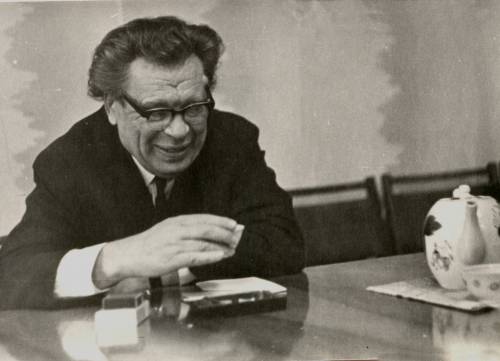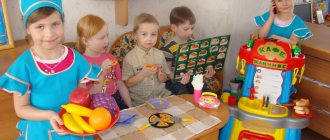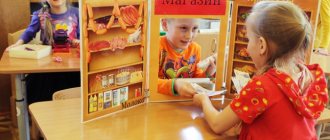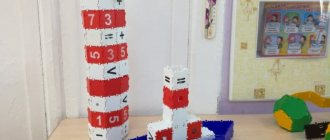STRUCTURE OF PLOT-ROLE-PLAYING GAME.
A role-playing game has the following structural components : motive, theme, game concept, plot, role. Motive: Initially, this role is played by a role-playing action that arises as the child masters the objective world. In the process of development of the plot-role-playing game, it changes. Gradually, the motive for role-playing games becomes the possibility of interaction - playful, non-verbal, verbal - with other participants in the game. Theme : represents the area of social reality that is contained in the game .
The theme of role-playing games changes in accordance with the age of the children playing, as well as with the content of programs for the education and training of preschool children.
Game design: This is a general definition of the theme of the game, a definition of what and how children will play. The main component of a role-playing game is the plot ; without it, there is no role-playing game itself. The plot of the game is the sphere of reality that is reproduced by children. The plot is a child’s reflection of certain actions, events, relationships from the life and activities of those around him. At the same time, his play actions (turning the steering wheel of a car, preparing lunch, teaching students to draw, etc.) are one of the main means of realizing the plot . The plots of the games are varied . Conventionally, they are divided into household (family games, kindergarten), industrial , reflecting the professional work of people (games to the hospital, store, etc.), public (games to celebrate the city’s birthday, to the library, school, etc. .).The content of the role-playing game is embodied by the child through the role he takes on. Role: It is a means of realizing the plot through role-playing action, role-playing dialogue, role-playing actions and role-playing speech.
For a child, a role is his playing position : he identifies himself with a character in the plot and acts in accordance with ideas about this character. Every role contains its own rules of behavior , taken by the child from the life around him, borrowed from relationships in the adult world. So, the mother takes care of the children, prepares food for them, puts them to bed; The teacher speaks loudly and clearly, is strict and demands attention in her lessons. Submission of the child to the rules of role-playing behavior is the most important element of role-playing play. Deviation from the rules by anyone or those playing causes protests from the playing partners. That is, for preschoolers, a role is an example of how to act. Based on this sample, the child evaluates the behavior of the participants in the game, and then his own Role speech : these are those words, phrases, sentences, monologues and dialogues that the child uses to indicate his role and during role-playing interactions with play partners. Game actions: these are the actions that the child performs in accordance with the role taken and in the course (logic) of the plot.
— Reflective
- copies the actions of real life.
— Fine
- actions are more condensed, words are used as if.
Game material : that object-based game environment that helps the child realize his game plan.
DEVELOPMENT OF THE CONTENT OF ROLE-PLAYING GAMES IN PRESCHOOL AGE.
| Age | Nature of game actions | Performing a role | Plot development in an imaginary situation |
| 3-4 years | Separate game actions that are conditional in nature | The role is actually performed, but not named | The plot is a chain of two actions, the imaginary situation is held by an adult |
| 4-5 years | Interconnected game actions with a clear role-playing character | The role is called, children can change the role during the game | A chain of 3-4 interconnected actions, children independently hold an imaginary situation |
| 5-6 years | Transition to role-playing actions that reflect the social functions of people | Roles are assigned before the game starts, children stick to their role throughout the game | A chain of game actions, united by one plot, corresponding to the real logic of the actions of adults |
| 6-7 years | Representation of relationships between people (subordination, cooperation) in game actions. The technique of game actions is conventional | Not only the roles, but also the idea of the game are spoken out by the children before it begins. | The plot is based on an imaginary situation, the actions are varied and correspond to real relationships between people |
*****at 1.5-3 years, a child can carry out conditioned actions with toys and substitute objects, building them into a simple semantic chain, entering into short-term interaction with a peer; **** at 3-5 years old - can accept and consistently change play roles, implement them through actions with objects and role-playing speech, enter into role-playing interaction with a peer partner; **** at 5-7 years old - develop various sequences of events in the game, combining them according to your own plan and the plans of 2-3 peer partners, implement plot events through role-playing interactions and objective actions
STAGES OF THE APPEARANCE OF S.R.I.
Story-based role-playing game
A child goes through several stages in its development. Consistently replacing each other:
- introductory game,
- display game,
plot-display game, plot-role-playing game. The first stage in the development of gaming activity is the Introductory game . Based on the motive given to the child by an adult with the help of a toy object, it represents an object-based play activity. Its content consists of manipulation actions carried out in the process of examining an object. This activity of the infant very quickly changes its content: the examination is aimed at identifying the characteristics of the object-toy and therefore develops into oriented actions-operations.
The next stage of gaming activity is called Display Game , in which individual object-specific operations become actions aimed at identifying the specific properties of an object and achieving a certain effect with the help of this object. This is the culmination of the development of the psychological content of play in early childhood. It is he who creates the necessary soil for the formation of appropriate objective activity in the child.
At the turn of the first and second years of a child’s life, the development of play and objective activity converges and at the same time diverges. Now the differences begin to appear in the methods of action - the next stage in the development of the game begins: it becomes plot-representative. Its psychological content also changes: the child’s actions, while remaining objectively mediated, imitate in a conditional form the use of an object for its intended purpose. for a role-playing game gradually become infected .
At this stage of development of the game, word and deed come together, and role-playing behavior becomes a model of relationships between people that are meaningful to children. of the actual role-playing game begins , in which the players simulate the labor and social relations of people familiar to them.
16.MODERN APPROACHES TO PEDAGOGICAL GUIDANCE OF PLOT-ROLE-PLAYING GAMES. When leading role-playing games, educators are faced with the following tasks:
• development of games as an activity (expanding the themes of games, deepening their content);
• using the game to educate children's groups and individual children,
Directing a role-playing game requires great skill and pedagogical tact. The teacher must direct the game without disturbing it, and maintain the independent and creative nature of the game activity.
Indirect techniques - without direct intervention in the game (bringing in toys, creating a play environment before the start of the game).
Direct techniques - direct involvement of the teacher in the game (role-playing participation in the game, participation in the collusion of children, explanation, help, advice during the game, suggesting a new topic for the game, etc.). The teacher influences both the choice of topic and the development of its plot, helps children distribute roles, filling them with moral content.
The following pedagogical approach is presented in the studies of S. L. Novoselova and E. V. Zvorygina, who developed a comprehensive method for managing the game. The integrated method of guidance is a system of pedagogical influences that promote the development of children’s independent story-based play, based on its age characteristics and the potential development of the child’s intelligence.
This method includes the following components: - systematic, pedagogically active enrichment of children’s life experience;
- joint (educational) games between the teacher and children, aimed at conveying to them the gaming experience of the traditional culture of play; — timely changes in the subject-game environment, taking into account the enriching life and gaming experience;
- activating communication between an adult and children, aimed at encouraging them to independently use new ways of solving game problems and new knowledge about the world in the game.
INTRODUCTIONAL GAME FOR A CHILD
An introductory game is an object-based game activity based on a motive given to a child by an adult using a toy object. Its content consists of manipulation actions carried out in the process of examining objects.
Children as early as two or three months watch adults approaching or moving away from them and fix their gaze on a brightly colored object. Moving their hands chaotically, they accidentally bump into objects on which their gaze is focused. This develops visual-motor coordination, and in the process of palpating movements, specific tactile sensitivity is formed and the palmar surface of the child’s hand is transformed into an orderly working receptor apparatus. Moving or bright objects become the object of the child's attention, stimulating his own movements. After grasping movements, children develop “rotary and chain movements”: patting an object, waving them, transferring an object from one hand to another, hitting an object with an object, etc. One of the rotating movements is a rotating movement of the eyes (looking at an object).
Rotary and chain reactions, accompanied by examination of the object being manipulated, are the main actions of a child in the first months of life in studying objects.
If you constantly diversify toys in size, weight, shape, elasticity, surface features, sound, etc., then the child will gradually develop so-called object-specific actions based on indicative actions. For example, a baby notices a groove or bulge on a rattle and runs his finger along it, squeezing and unclenching the rubber toy, causing it to squeak.
It is of great importance that an adult brings toys and shows the child possible manipulative actions with them. Communication between a child and an adult is the leading activity of the first year of life.
As observations show, the first games of a plot nature enter the child’s life with the help of the mother (or another close adult), who, wanting to amuse him and provoke activity, reads to him short, simple poetic texts such as “Magpie-Crow”, well-known to everyone, “Ladushki”, “Horned goat”, etc. At the same time, the mother not only says that “Magpie-crow cooked the porridge...”, but also conventionally demonstrates the actions of stirring the porridge, reinforcing them with appropriate intonation and facial expressions. First, all play actions are performed by an adult. After some time, he begins to stimulate the actions of the child himself: while reciting a poem, he asks the baby: “How did the magpie cook the porridge? Show me!” - and the child responds with appropriate actions. An adult uses a game as a means of communication with a child, as a holistic activity that includes all the components of the game’s plot: characters, their actions, objects (the objects in this case are hands and fingers).
So, the child becomes a participant in a story game organized by an adult at 8-10 months of age. However, this does not indicate that the child has developed story-based play. The adult is playing, the child is included in the game only as a spectator; his participation in it is expressed only in the repetition of individual, very simple actions. Gradually, the adult increases the child’s participation in the game and invites him to join the game together. Thus, play turns from a means of communication with a child into a joint play activity between an adult and a child.
In the process of manipulative games, the child masters the physical properties of things and objects, learns his own possibilities of influencing the object. In this regard, at this stage it is important to develop children’s visual and auditory concentration, to teach them how to operate with objects, which will be a prerequisite for the transition of play activity to a qualitatively new level.
Components - where to look for them?
Honestly, I pestered all my colleagues, trying to find out what these same components were, but I really didn’t achieve anything. Many simply asked: “Why do you need this?” – very original, isn’t it?
Of course, theory is quickly forgotten in the practical activities of a teacher. We do some things, but find it difficult to say what they are called. “Uncle Google” will have to name the components of a role-playing game...
It is clear that the components of role-playing children's fun are everything that is associated with organizing these events with preschoolers. For example, a playing space that is provided with suitable attributes.
By the way, my favorite online store Ozone offers many options for attributes for story-based fun, which extremely diversify thematic corners in the group. What can I say, if a child sees a cool toy, he will immediately be inflamed with the desire to find a creative use for it. Yes, cardboard crafts are a useful thing, whatever one may say. But how much more impressive do real children's kitchens look, say, or store counters with colorful goods!
But let's get back to our sheep, as they say. So, what is meant by the components (structure) of story-based fun for preschoolers?
The main components of the role-playing game activity contain:
- Plot;
- Content;
- Rules;
- Role;
- Actions;
- Relationships;
- Substitute items;
- Imaginary situations;
- Partners.
In general, that’s what I thought, but it was difficult to formulate clearly. Maybe someone will find my work on summarizing information useful?
These are the main components of a standard plot-role-playing children's game according to D.B. Elkonin, a Soviet psychologist who dealt with issues of child psychology, in particular the psychology of play. He identified levels of story-based children's fun that reflect their development throughout the preschool period of childhood.

Is it worth writing down each item on the list? I’m sure all educators know what a role, a plot, an action are... I just needed to provide you with a clear answer to a specific question: what, in fact, are the components of any plot-role socializing game that pedagogy highlights?
I will only share my own observations about the peculiarities of role-playing fun for our children. You understand that the plots, roles and other components of the games of modern children are radically different from the games that our grandmothers played (if they played at all in their most difficult, hungry wartime).


